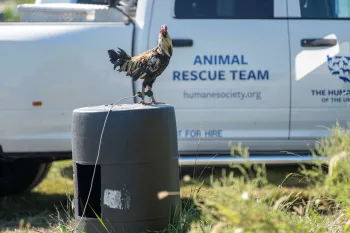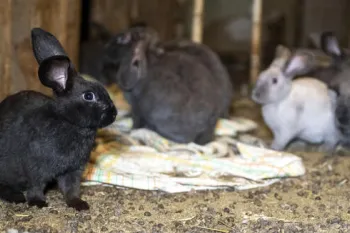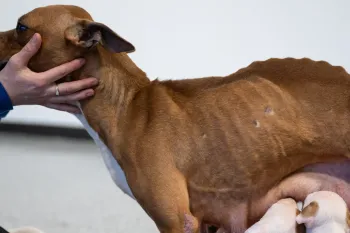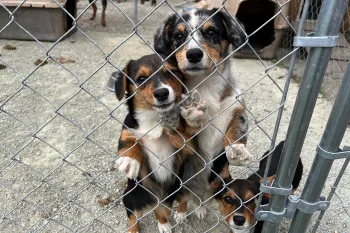Dozens of small makeshift huts were recently found on a rural property in Iowa. Some were little conical hovels; others, overturned water tanks and chemical barrels with holes cut out of them. Inside each was a solitary rooster tethered to the enclosure. The only water accessible to the birds was in slimy, debris-filled bowls. Other roosters, hens and their chicks roamed among these structures. Many of the birds were missing their combs and waddles. These are the signs of a cruel, illegal industry: cockfighting.
While it does not appear that cockfights were conducted on the property, over 400 roosters and chickens were present on the scene when our Animal Rescue Team arrived last week. Authorities suspect these birds were being bred and sold for the purpose of cockfighting. The Appanoose County Sheriff’s Office requested our help after forming a connection with members of our team at a recent law enforcement training on large-scale animal cruelty cases that we conducted in June.
In cockfighting, roosters are forced to fight to the death. Cockfighters attach razor-sharp blades to the birds and watch as their eyes and bodies are punctured, sliced and gored. Spectators bet on the animals’ will to survive, for gambling and entertainment.

Kevin Wolf/AP Images for the HSUS
The wrongs associated with animal fighting extend beyond the immediate harm inflicted on animals. Participants in these activities are often implicated in a range of criminal behaviors, including child abuse, murder, assault and human trafficking. Investigations into animal fighting rings have revealed complex criminal networks with ties to organized crime, drug trafficking and illegal firearms. Animal fighting is not an isolated crime but part of a larger web of criminal activity that jeopardizes the safety of communities wherever it exists.
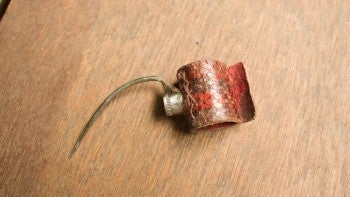
The HSUS
Cockfighting is a huge national problem. Our research in Kentucky, Georgia, Oklahoma, North Carolina and California, along with figures from gamefowl breeder associations (which are part of the cockfighting industry), revealed there could be as many as 10,000 fighting bird breeders in just those five states.
Law enforcement is a critical ally in our work to put an end to animal fighting. Earlier this year, in a landmark resolution, the National Sheriffs’ Association formally recognized animal fighting as a grave crime of violence. The resolution affirms what many of us have known intuitively for a long time: violence can reverberate through communities in heartbreaking and insidious ways.
It seems astounding that even today, such overt and gratuitous violence towards animals still exists. Even more astounding, perhaps, are the formalized efforts to take progress against animal fighting in the wrong direction. A group of cockfighters and pro-cockfighting individuals known as the U.S. Gamefowl Commission have come together to try to reduce or eliminate penalties for cockfighting, host pro-cockfighting rallies, and to fundraise and donate to legislators in attempts to decriminalize cockfighting. Such efforts are an insult to progress for animals in the eyes of the law and of society.
Meredith Lee/Humane World for Animals
End cockfighting
This case in Iowa shows that even states with strong laws against animal fighting remain at risk of the industry's supporters and operators secretly setting up shop, where they quietly export birds to a life of cruelty in other states or internationally.
Leaders of the gamefowl group suggest that raising and trafficking birds should be legal. Thankfully, law enforcement generally opposes these efforts, the National Sheriff’s Association’s resolution urging “the nation’s state, local, and federal governments to condemn dogfighting and cockfighting in the strongest terms possible by passing and maintaining penalties for the crimes.”
Part of the tragic reality of cockfighting is that there are very few options for rehoming birds who have been bred for or used in cockfighting. Often the birds must be euthanized to prevent disease spread, or because there are no other options for them. Still, such a fate is more humane than that of the hundreds of thousands of birds who are forced to live in extreme isolation before being forced to fight to the death, typically bleeding out with punctured eyes and lungs, while spectators cheer.
Authorities are currently assessing the health of the birds and determining what their options are. What’s for certain is that they will never have to suffer slow, painful deaths in a cockfighting pit.
We are immensely grateful to the Appanoose County Sheriff’s Office for its work on this case and its commitment to keeping their communities safe from the many harms of animal fighting. And we are steadfast in our determination to end animal fighting once and for all by shining a light on the ills it creates and by working with law enforcement agencies, legislators and everyone who seeks to create a world in which violence against animals is condemned, not celebrated.
You can join us in our efforts to do right by animals.
Follow Kitty Block @HSUSKittyBlock.
